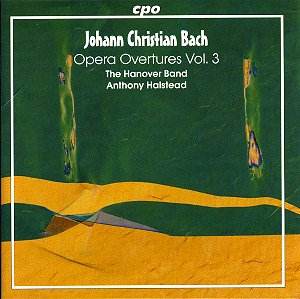I have yet to find a piece of music by J. C. Bach which has
failed to delight. The so-called 'London Bach' (he moved to the UK capital
in 1762 and spent the rest of his life here) enjoyed considerable success
during his 46 year life-span. His skill in orchestration and his ability
to evoke a number of emotions are demonstrated on this excellently-recorded
collection of Opera Overtures and Ballet Music.
The first two overtures on this disc, Endimione, G15
and Temistocle, G8, date from 1772. 'Endimione' was first performed
at the King's Theatre, Haymarket, London on April 6th of that year,
with the composer's future wife, the soprano Cecilia Grassi, taking
the part of Diana. Typically for his opera overtures, it begins in festive,
jubilant manner: the energy generated, particularly in this performance,
is utterly captivating. This movement is full of life, contrasting perfectly
with the gallant, elegant Andante. The finale foregrounds hunting-horn
calls, presumably representing Diana (goddess of the hunt).
'Temistocle' was commissioned by Prince Carl Theodor
and was premiered as the opening opera for the Mannheim season beginning
in November 1772. The subject also tempted the likes of Caldara, Porpora
and Jommelli. Again, the opening movement (of three) is lively, although
the actual level of invention is less than that displayed by 'Endimione'.
The score is interesting, nevertheless, for its inclusion of three clarinetti
d'amore in the slow movement (characterised by a somewhat throaty timbre)
and also for the bustling Presto finale, a first cousin to Mozarts 'Le
nozze di Figaro' overture in intent.
The title of 'Lucio Silla' (G9) will be familiar to
collectors from the Mozart opera of the same name. J. C. Bach's opera
came about as a direct result of the success of 'Temistocle', and in
fact it began the opera season of the very next year in Mannheim. According
to Andreas Freisenhagen's well-informed booklet notes, this overture
is 'regarded as one of Bach's best orchestral works of all': and certainly
there is little arguing with the compositional skill employed here.
The Overture and Ballet Music from 'Amadis des Gaules,'
(G39, 1778/9), Bach's last opera, takes up nearly half of the total
playing time of the disc. It was written for the Academie Royale de
Musique in Paris, but was not a success when presented there in December
1779, in the midst of the French-versus-Italian opera debate raging
amongst Parisians. As far as 'Amadis' is concerned, the ballet music
is a distinctly French trait, whereas the three movements of the Overture
represent the Italian influence.
The highlight of the ballet music is the penultimate
'Ariette et choeur' for (uncredited) tenor and orchestra: a superbly
crafted piece. The final, zippy, celebrational 'Tambourin' forms an
excellent conclusion to this fine disc.
All performances by the Hanover Band under Anthony
Halstead are of the highest order and will give the greatest pleasure.
Recommended.
Colin Clarke


